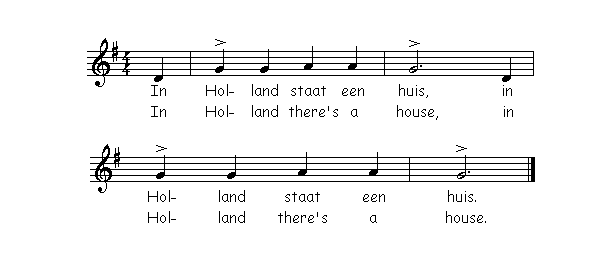METRE AND RHYTHM - UPBEAT
When a music piece starts with an incomplete bar we call that an upbeat. In that case the music piece will end
also with an incomplete bar. The first and last bar together will be one complete bar. In the example on this page
you see only one beat in the first bar and 3 beats in the last bar.
Together they are one complete bar in a 4/4-metre.
Why do we use such an upbeat. Is it necessary? When we speak, some parts of the words have an accent and other don't.
When we would change the places of the accents, it would sound very strange. So it is very natural to give the words
the accents on the right places. A melody from a music piece also has notes with an accent and notes without.
Normally the accents are always on the first beat of every bar.
In the example, a Dutch childrens song, you see them with the special accent-signs (" > ").
When we speak, we can start with a word without accent. In a music piece we can do the same; start with a note without accent.

In a song, such as the one in the example, the lyrics and the melody go together. When you want to make it sound well,
you have to take care of putting the accents of the metre and the accents of the lyrics on the same place. The first word
"in" has no accent. But the part "Hol-" it has an accent. So that part of the word has to be placed on the first beat
of the bar. The word "in" will come before that first beat of the bar, so on the 4th beat of the previous bar. Now we have an upbeat.

